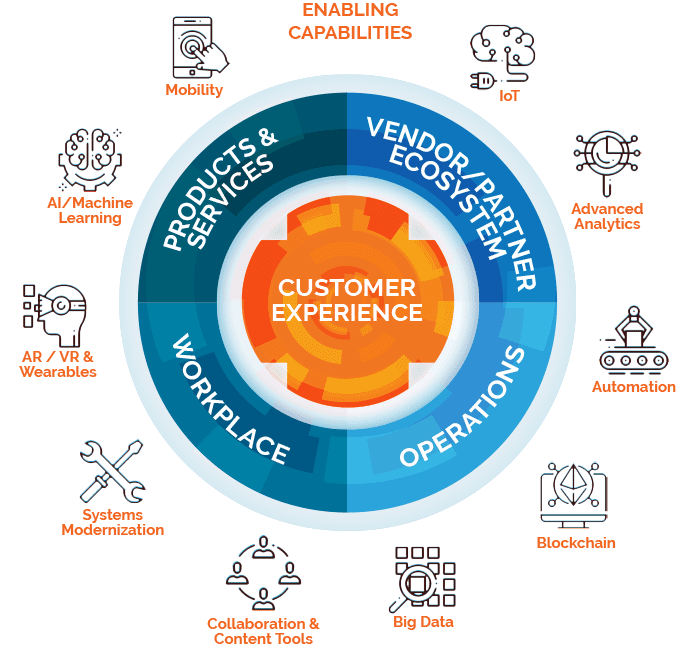12 Steps to Robotic Process Automation Adoption: A Practical RPA Checklist
Robotic Process Automation (RPA) has evolved from a “good to have” to a “must have” in the digital transformation of business. We’ll cover the critical need to knows on the automation journey through our practical RPA checklist.
Some business experts would argue that if an organization hasn’t begun their automation journey by now, they’re already behind the digital transformation curve. Robotic process automation specifically has made tremendous strides in business through the years. A technology platform once thought to only streamline mundane/repetitive tasking has now evolved into an intelligent automation entity, capable of enhancing complex/data-driven tasks in various functions.
Businesses at the start of their automation journey may not know where to begin this endeavor. After all, there are various aspects to consider, such as costs, technology providers, employee impact, governance and strategy. Further, the possibility of scaling RPA implementations (once off the ground) might sound foreign to early adopters.
For organizations wondering how to get started with robotic process automation, our detailed and practical RPA checklist will guide you through the critical need-to-knows every business should consider for a successful automation implementation, and how to align a path to achieve RPA at scale.
1. EMBRACE automation as a corporate strategy with sponsorship at the C-Suite
Today, every business is competing for shareholder investments with other businesses, like Google and Apple, who may offer faster and higher returns. Businesses must transform themselves, and demonstrate their ability to grow top-line and reduce G&A costs. Robotic Process Automation (RPA) and Artificial Intelligence (AI), when adopted wisely, will deliver the business outcomes desired.
Such vision and sponsorship should be driven from the top (C-Suite) to digitally transform the organization with automation. Establish a business-focused enterprise automation strategy and roadmap (EASR) that lays the groundwork for successful adoption and business-value creation for your organization. This strategy should highlight the opportunities for automation across the organization (the processes, people, and technology) required for establishing a sustained high performing RPA program to respond to business needs with agility.
2. EDUCATE leaders and set realistic expectations
Business processes are a set of rules that people execute to achieve desired outcomes. A collection of such rules when stitched together becomes an algorithm that can possibly be automated by a computer. RPA has the potential to make a significant impact on an organization, though it is not a panacea for solving all internal business problems.
As RPA bots perform the same processes as humans, gaps that cause revenue leakage will simply worsen due to its speed of execution and lower human checks. Sometimes, repetitive tasks are best addressed with other solutions: API, upgrades, or a change in technology entirely.
Stop your RPA projects from going off track, or failing to solve problems they were never capable of solving. An educated executive will be the best proponent of RPA for the right use cases, and will avoid wasting money on wrong ones.
3. ESTABLISH a clearly defined RPA-based strategy
Best practice methodologies from leading authorities, such as McKinsey, Gartner, and Accenture, will always focus on aligning the business strategy with people, process and technology aspects for success. If any of these are ignored, the strategy is likely to fail. Smartbridge’s RPA strategy framework follows these best practices, and aligns these three essential elements with the business strategy.
The strategy should ultimately aim for hyperautomation of end-to-end business processes using a combination of robots and humans, applying technology tools that include machine learning, packaged software, and automation tools to deliver dramatic results. Understand that what your people do will be impacted with the RPA-enabled processes, define the new ways employees must work in the digitally enabled environment, and establish structures to make them knowledge workers.
4. ASPIRE for revenue generation and act on quick wins rapidly
RPA bots do repetitive activities more quickly, accurately, and tirelessly than humans, working 24-7 to free up employees to focus on tasks requiring emotional intelligence, reasoning, judgment, and interaction. These higher-value activities will increase your bottom line because now your business is doing more than it was before, with the same number of people. Companies must swing into action with RPA, establish a structure for success, and drive automation focusing on “low-hanging fruit” first. Celebrate successes and move onto higher value automation opportunities.
Further, with low- and no-code RPA development platforms, it’s never been easier for business users to create their own automation solutions that move the needle on revenue generation, cost reduction, and business growth. These citizen developers will be the ones with creative ideas to improve areas of business that impact them personally that will result in improved process efficiency and ultimately a larger bottom line for companies.
5. IDENTIFY and qualify RPA-enabled revenue generation opportunities
Several use cases for automation can be found in marketing, sales and customer care functions. Marketing is collecting, processing and acting on customer-related data every day. Sales deal with customer interactions in a variety of ways that can be managed by auto-organizing and auto-response bots.
Customer care is responding to a variety of requests, which in some cases, can be replaced by automated self-service response bots. Often there are several manual processes in these functional areas that can be automated. Our digital transformation framework (as shown on the right), establishes that transforming the way companies engage with customers to maintain high levels of satisfaction can drive revenue.
Using our digital transformation framework (as shown on the right), end-to-end processes may be hyperautomated to enable optimal human-robot interactions to create a superior customer experience.

6. IDENTIFY and qualify RPA-enabled opportunities to automate wasteful activities
Four of the five target areas in our digital transformation framework are operations, products and services, workforce, and vendor/partner ecosystem. These are internal process areas that companies must transform to realize the promise offered by digital transformation.
Companies will often find several manual activities that are being performed by hundreds of office workers that can be automated. Some common use cases that are ripe for automation are:
7. START with the non-intrusive approach on standardizing processes
Initial RPA implementations often focus on “low-hanging fruit” use cases. The most obvious and common use cases for deploying RPA bots are in business functions in which people perform data entry. This requires taking data from one system and entering it into another, to connect data across systems while also completing business processes. We often find several use cases in finance and human resources departments to begin a company’s RPA journey.
These quick wins may be implemented using unattended or attended automations. Unattended automation is intended for highly repetitive tasks, usually needing to be performed in batches, that can be decided based upon a predefined rule. Attended automations run under human supervision and, because of this, are best suited for use with smaller, more fragmented tasks that are usually housed within a specific department or division within a company and is accessible to employees immediately connected or involved with the process.
8. SCALE RPA activities in a phased manner – pilot, to POC, to full scale
This is perhaps the most critical component in our RPA checklist. While automation has been around for a long time, it was applied in select cases with tech-savvy programmers. RPA that is being discussed today is a topic surrounding digital transformation, enabled by the advent of special purpose RPA tools such as UiPath and Microsoft Power Automate. As a result, standards and methodologies are evolving, skills are in short supply, and executives desire to automate everything in sight without full awareness.
Many of these manual, time-consuming and inefficient tasks and activities are being performed by line employees; these employees are best suited to create automations to address role or department-specific automations. To enable scaling of automation in the organization, it is key that these employees are empowered to be able to identify, design, develop and implement these automations. These are your Citizen Developers – the building blocks of your scale-up strategy.
9. DEFINE and implement a governance model
Regardless of its task, a robot’s essential job is to make the company vision come true. To realize this vision, businesses should establish an internal, self-sustaining and scalable RPA expertise to build, run and maintain the robots. Businesses must treat RPA as an enterprise capability, and resist the temptation to make quick wins by implementing automation silos that only bring short-term benefits.
Implementing RPA should be treated as a corporate wide initiative, not a series of stand-alone projects that may or may not align with corporate goals and standards. The governance body and RPA Center of Excellence (CoE) are the mechanisms to embed automation deeply into the organization, and redistribute knowledge across various business units and towards future deployments.
Governance should address not only the needs of the CoE, but also the needs of the Citizen Developer with the rules of the road for leveraging the assets, structure and practices created by the organization.
10. BUILD an implementation team with the right expertise mix
Automation initiatives should rightfully start in the business. However, a variety of skills such as project management, business process documentation and analysis, RPA tools, architecture, database technology, and VB scripting are required to successfully implement RPA bots.
We at Smartbridge, while working with companies exploring automation with RPA technologies, often find that the initial forays into RPA are made by tech-savvy business analysts, not IT. However, soon after building an initial prototype, they often find themselves at a dead-end, trying to figure out what they should do next to operationalize the prototype.
11. DEVELOP a solid plan to manage the operational aspects of the bots
Any business process, regardless of whether it is manual or automated, needs caring and feeding. They change as the business evolves in today’s rapid transformation environment, exceptions occur frequently, and situations need to be addressed and managed.
“Implementing RPA should be treated as a corporate wide initiative, not a series of stand-alone projects that may/may not align with corporate goals.”
– Sri Raju, Smartbridge CEO
Bots may unexpectedly stop running, unable to handle exceptions in this manner. Technical changes in underlying systems or software versions may also break the bots.
Successful companies undergoing digital transformation proactively plan for these occurrences, and establish operational management mechanisms for their RPA bots in production. Our automation managed services monitor our customer’s bots, and execute processes to maintain high up-time availability.
12. MARKET what RPA means to the organization
RPA creates tremendous opportunities to grow revenue and reduce G&A costs. These opportunities can only be realized if the executive leadership embraces automation, actively sponsors and supports this initiative, and effectively communicates with the workforce to allay fears and drive a transformative mindset. This transformation should start with a shift in the C-Suite area.
As RPA adoption grows in the organization it is important to keep the momentum by deploying initiatives such as an RPA Day open to all employees to experience RPA in-person, as well as hackathons that create and foster a culture of innovation in the organization.
Keep Reading: Getting Started with RPA Implementation
Looking for more on RPA?
Explore more insights and expertise at smartbridge.com/automation
There’s more to explore at Smartbridge.com!
Sign up to be notified when we publish articles, news, videos and more!
Other ways to
follow us:



